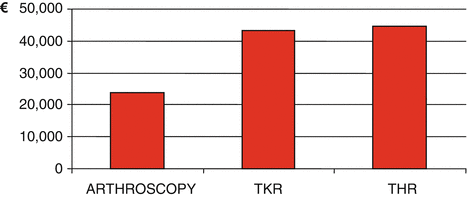Alternatives
Costs (€)
Results (QALY)
Increase of costs
Increase of QALYs
Cost/effectiveness ratio (€/QALY)
No treatment
0
0
200,000
10
20,000
Secondary prophylaxis
200,000
10
On-demand treatment
100,000
9
100,000
1
100,000
Secondary prophylaxis
200,000
10
Secondary prophylaxis
200,000
10
100,000
10
10,000
Implantation of TKR
300,000
20
1.
No treatment, with no cost but 0 QUALYs.
2.
Secondary prophylaxis (factor infusion 2–3 times per week to avoid joint bleeds) with an annual cost of € 200,000. In this case we estimate that the patient will gain 10 QUALYs. This alternative would cost € 200,000 more than alternative one (no treatment). Each QUALY would cost € 20,000.
3.
On-demand treatment (factor infusion only during bleeding episodes), with a cost of € 100,000. In this case we estimate that the patient will gain 9 QUALYs.
4.
The fourth alternative would be to perform a TKR with an estimated cost of € 300,000 but with 20 QUALYs.
In this case the most favorable option from the pharmacoeconomic point of view would be the implantation of a TKR.
Cost/effectiveness studies have an important disadvantage: they are not valid to decide whether an alternative treatment must be performed because it is not the same to assume a cost in the context of economic bonanza than in times of recession. Economic evaluations are not intended to conclude whether a treatment can or should be used. They are intended to specify and compare costs and consequences, with the aim of facilitating the decision-making. The goal is to improve the efficiency of a particular therapy.
One issue to be considered in economic evaluations is the temporary space. For instance, the implantation of a TKR in a hemophilic patient has an immediate cost, but also long-term benefits. There is no doubt that immediate benefits are usually preferred. Benefits and costs, however, cannot be separated from the time period in which they occur. The application of the so-called discount rate in economic assessments incorporates the aforementioned temporary circumstances, as the costs and benefits that arise in the future are usually valued less. The discount rate applied varies between different countries but ranges from 3 to 5 %. This circumstance is very important when transferring the results of a pharmacoeconomic study in a particular country to another country, so the results should be interpreted with caution.
The robustness of the results in studies of economic evaluation is supported by sensitivity analyses. A sensitivity analysis is necessary in CEA analyses because the own nature of the studies assume values of variables that are not verified in any part of the analysis, creating uncertainties in its results. To minimize these uncertainties, we must compare the results of the variables involved with an estimation range, holding constant the other variables. If the incorporation of the various estimates does not substantially change the findings, it may be considered that the study has a high degree of reliability and its conclusions are sound.
15.4 Cost of Orthopedic Surgery in Patients with Hemophilia
Patients with hemophilia undergoing orthopedic surgical procedures should be treated throughout the perioperative period with the intravenous infusion of factor concentrates to control their hemostasis. The high cost of these drugs increases the cost of the process significantly. It is estimated that over 90 % of the total cost of the surgical procedures in hemophilia is due to the drug therapy used. In orthopedic surgery of hemophilia, the pharmacoeconomic analysis may ignore other associated costs. Thus, considering only the costs of factor concentrates, one can obtain a fairly accurate estimate of the cost of the surgical procedure.
Over the last 7 years our multidisciplinary hemophilia team has performed 60 surgical orthopedic procedures with a total cost of more than two million euros. Such procedures include arthroscopic debridements (knee, ankle) and TKRs and THRs. The cost of each of these procedures can be highly variable (Fig. 15.1).


Fig. 15.1
Cost of some orthopedic procedures performed in our center (in euros). TKR total knee replacement, THR total hip replacement
A number of factors can influence on the variability of costs. The most important are: the severity of hemophilia, the patient’s weight, the type of surgery, and the origin of factor concentrates used. The estimated cost of arthroscopic surgery in hemophilia ranges between 20,000 and 30,000 €, depending on the type of factor used in the intervention.
Most common surgical procedures in hemophilia patients are TKR and THR. The cost of these procedures ranges between 40,000 and € 50,000. THR is 2–3 % more expensive than TKR. Taking into account that the hemostatic protocols used in our center are very similar in THR and TKR, the variability in cost may be due to other factors such as patient weight, type of factor used, and days of postsurgical hematological treatment. It is important to emphasize that the aforementioned costs are related only to the perioperative period, not to the subsequent hematological treatment needed for postoperative rehabilitation (1–2 months).
Stay updated, free articles. Join our Telegram channel

Full access? Get Clinical Tree








